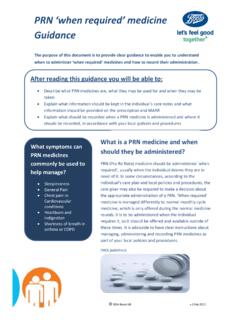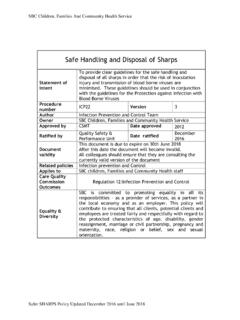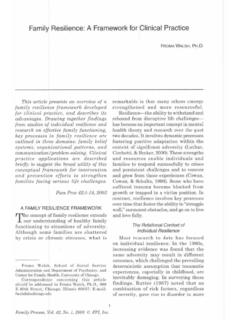Transcription of Identifying Neglect – The Risk and Resilience Model and Matrix
1 19We are working together to keep children and young people safe in CumbriaIdentifying Neglect The Risk and Resilience Model and MatrixWhat is Resilience ? Resilience is a key factor in protecting and promoting good mental health. It is the quality of being able to deal with the ups and downs of life, and is based on self-esteem. Fonagy defines Resilience as normal development under difficult circumstances. (Fonagy,P. et al (1994) The theory and practice of Resilience . Journal of Child Psychology and Psychiatry. 35, )Rather than rescuing so-called survivors from dysfunctional families , this practice approach engages distressed families with respect and compassion for their struggles, affirms their reparative potential, and seeks to bring out their best qualities. (Walsh (2008) Pg 31, Barlow & Scott, op cit,)The Risk and Resilience Model has been developed to support practitioners to understand the interaction between the factors and gain some sense of the risks of impairment to the child s health and development and plan Risk and Resilience Model by Daniel and Wassell (Daniel, B.)
2 And Wassell, S. (2002) The early years; assessing and promoting Resilience in vulnerable children (1). London: Jessica Kingsley.) Resilience looks different for each age and stage of development although some factors are common no matter what age. Even though there are common and known factors for children, what is not known is how each area will interplay with the other to affect the individual child. Resilience and vulnerability are internal characteristics which are shaped by the child s own genetic and nature / nurture factors, along with their own character and how they perceive and respond to situations. Internal characteristics Vulnerability > Resilience Assessing Resilience is important because it is associated with better long-term outcomes for children, therefore it can be used to guide planning for children whose lives have been disrupted by abuse of Neglect and who might require to be looked after away from home (Gilligan, 1997).
3 It cannot be looked at in isolation, as the extrinsic factors of protective and adverse environments will interact with the internal Model of the child. External characteristics Adversity > Protective environment 20We are working together to keep children and young people safe in CumbriaAdversity and protective factors come from outside the child, in the behaviour of adults, the resources available in the community and the ability of the child and family to make use of these. Combined, these areas create a balanced picture of the child, their family and the environment they live in, and how they interact with each other. It is important to remember that a child is not a passive receptacle. Interactions between themselves and other people and the environment in which they live will shape their experiences and development.
4 How they respond to adversity will depend upon their own Resilience and vulnerability. It is in observing and analysing the interactive factors of Resilience , vulnerability, adversity and protective factors that we start to understand how best to begin to meet the child s needs. Understanding risk and Resilience factors There are a number of common Resilience and vulnerability factors identified for different age groups. Once these factors are identified within the individual child the question has to be asked: What is nurturing or hindering the factors that influence the child s life? Each identified factor should be examined against this question. 21We are working together to keep children and young people safe in Cumbria Resilience Good attachment Good self-esteem Sociability High IQ Flexible temperament Problem solving skills Positive parenting Attractive VULNERABILITY Poor attachment Minority status Young age Disability History of abuse Innate characteristics in child/ family that threaten /challenge development A loner/isolation Institutional care Early childhood trauma Communication differences Inconsistent/neglectful care (Gordon, R.)
5 Et al, (2000) The Child s World Training & Development Pack, NSPCC) Resilient child High adversity Resilient Child Protective Environment Vulnerable child High Adversity ADVERSITY Vulnerable child Protective Environment PROTECTIVE FACTORS Variables Timing & age Multiple adversities Cumulative protective factors Pathways Turning points A sense of belonging Intervention Strengthen protective factors and Resilience Reduce problems and address vulnerabilities Achieve initial small improvements Adversity Life events/crisis Illness loss bereavement Separation/family breakdown Domestic violence Asylum seeking status Serious parental difficulties : drug abuse/alcohol misuse Parental mental illness Protective Factors Good school experience One supportive adult Special help with behavioural problems Community networks Leisure activities Talents and interests 22We are working together to keep children and young people safe in CumbriaSome common factors for child vulnerability Child vulnerability is the first conclusion you make when completing a risk assessment.
6 A judgment about child vulnerability is based on the capacity for self-protection. Self-protection refers to being able to demonstrate behaviour that results in defending oneself against threats to safety and results in successfully meeting one s own basic (safety) needs: Age children from birth to six are always vulnerable. Physical Disability Regardless of age, children who are unable to remove themselves from danger and are highly dependent on others are more vulnerable. Mental disability children who are cognitively limited are vulnerable in a number of areas; recognising danger, knowing who can be trusted, meeting their basic needs, and seeking protection. Perceptions of provocative behaviour a child s emotional, mental health, behavioural problem can be such that they irritate and provoke others to act out toward them or to totally avoid them.
7 Powerless regardless of age, intellect, and physical capacity, children who are highly dependent and susceptible to others are vulnerable. These children typically are so influenced by emotional and psychological attachment that they are subject to the whims of those who have power over them. Defenceless regardless of age, a child who is unable to defend him/herself against aggression is vulnerable. This can include children who are oblivious to danger. Remember that self-protection involves accurate reality perception particularly related to dangerous people or situations. Children who are frail or lack mobility are more defenceless. Non-assertive regardless of age, a child who is so passive or withdrawn to not make his or her basic needs known is vulnerable. A child who cannot or will not seek help and protection from others is vulnerable.
8 Illness regardless of age, some children have continuing or acute medical problems and needs that make them vulnerable. Common protective factors for Resilience building To achieve their maximum potential, children and young people will be protected by having all the things we know they need: good education; love and sense of belonging; decent standard of living; great parenting; intelligence; good looks; and opportunities to contribute.











